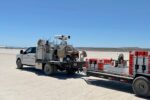Toronto-based Kepler Communications has secured a pivotal contract with the Canadian Department of National Defence (DND) to deliver satellite communications (SATCOM) services supporting Arctic operations. The deal underscores growing efforts by Canada and its NORAD allies to reinforce situational awareness and command-and-control capabilities in the increasingly contested High North.
Contract Overview: SATCOM Backbone for Arctic Operations
Announced in October 2025, the contract will see Kepler provide data relay services using its low-Earth orbit (LEO) satellite constellation. While financial terms remain undisclosed, the agreement is part of a broader Canadian initiative to modernize defense infrastructure under the Strong, Secure, Engaged (SSE) policy and NORAD modernization roadmap.
Kepler’s role focuses on delivering high-throughput communications in remote northern regions where traditional geostationary (GEO) satellites suffer from poor coverage and latency issues due to their equatorial positioning. The company’s LEO network offers lower latency and improved bandwidth at higher latitudes—critical advantages for real-time command-and-control (C2), intelligence-sharing, and persistent surveillance missions in the Arctic.
Technical Capabilities of Kepler’s Aether Network
At the core of this effort is Kepler’s proprietary “Aether” network—a commercial data-relay service designed for space-to-space and space-to-ground communications. As of late 2025, Kepler operates over 20 LEO satellites with plans to scale toward a constellation exceeding 100 nodes by 2026–2027.
The Aether system enables:
- Store-and-forward messaging: buffering data onboard until optimal downlink windows are available
- Real-time relay: for time-sensitive ISR or C2 applications via inter-satellite links (ISLs)
- Differentiated Quality-of-Service (QoS): prioritizing mission-critical traffic over routine telemetry
The architecture is designed with dual-use functionality in mind—supporting both government/military users and commercial customers such as maritime operators or polar research missions. For defense purposes, this allows integration into existing tactical networks without reliance on legacy GEO systems or terrestrial infrastructure vulnerable to disruption.
NORAD Modernization Context: Why Arctic Comms Matter
This contract aligns with Canada’s commitments under NORAD modernization—a joint U.S.-Canadian effort aimed at updating early warning systems, long-range radar coverage, and secure communications across North America’s northern approaches. The melting polar ice cap has opened new shipping lanes and increased Russian military activity in the region—raising concerns about surveillance gaps and response latency.
In March 2023, Canada pledged CAD $38 billion over two decades toward NORAD upgrades. Priorities include:
- Over-the-Horizon Radar (OTHR) systems for persistent detection
- Sovereign SATCOM capabilities for assured access during crises
- C4ISR enhancements tailored for extreme cold-weather operations
Kepler’s LEO network provides a resilient layer within this evolving architecture—particularly as adversaries invest in counter-space capabilities that may threaten traditional GEO assets. By leveraging commercial constellations like Aether alongside military-grade networks such as Iridium Certus or Skynet Viasat-3 integration paths, Canada aims to diversify its space-based comms portfolio.
Dual-Use Innovation: Commercial Tech Meets Defense Needs
The DND-Kepler partnership reflects a broader trend toward leveraging commercial innovation for military advantage—especially in domains like space where agility often outpaces traditional procurement cycles. Similar models have been adopted by U.S. Space Force through programs like Commercially Augmented Space Inter-Networked Operations (CASINO) or SDA’s Proliferated Warfighter Space Architecture (PWSA).
Kepler’s approach also aligns with NATO’s push for interoperability across allied forces operating in polar regions. As more unmanned aerial systems (UAS), maritime patrol aircraft like CP-140 Aurora or P-8 Poseidon variants operate over vast Arctic expanses with limited ground infrastructure, reliable beyond-line-of-sight comms become essential.
Strategic Implications: Toward an Integrated Northern Posture
This contract is not just about bandwidth—it signals Canada’s intent to build a layered defense posture integrating space-based ISR/sensor fusion with mobile ground stations and airborne platforms across the Arctic theater. Future phases may include:
- Tactical edge terminals compatible with Aether payloads on UAVs or forward bases
- SATCOM-integrated C-UAS systems deployed at key chokepoints like Resolute Bay or Alert Station
- Liaison architectures enabling joint operations with U.S., Danish/Greenlandic forces under NATO frameworks
The geopolitical stakes are rising as China also eyes polar routes under its “Polar Silk Road” initiative while Russia expands its Northern Fleet footprint. In this context, resilient comms are not just enablers—they’re critical deterrents ensuring rapid decision-making under contested conditions.
Outlook: Scaling Up Toward Full Constellation Deployment
If successful, Kepler’s deployment could serve as a model for other Five Eyes nations seeking sovereign yet commercially augmented space solutions. With launch partners including SpaceX rideshare missions and anticipated Ka-band upgrades post-2026, Aether could evolve into a full-spectrum ISR/C4ISR backbone supporting not only Canada but allied partners operating above the Arctic Circle.
The next milestones will likely involve field trials with CAF units operating out of Yellowknife or Goose Bay; integration testing with existing DND tactical radios; and potentially embedding Aether-compatible payloads on future RCAF platforms such as remotely piloted aircraft systems (RPAS).










